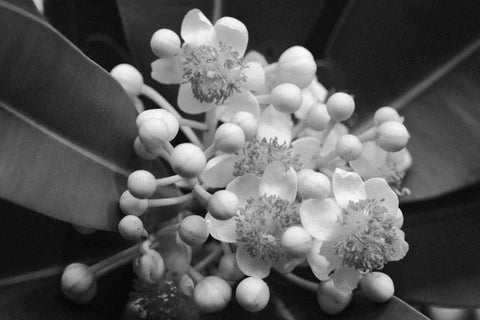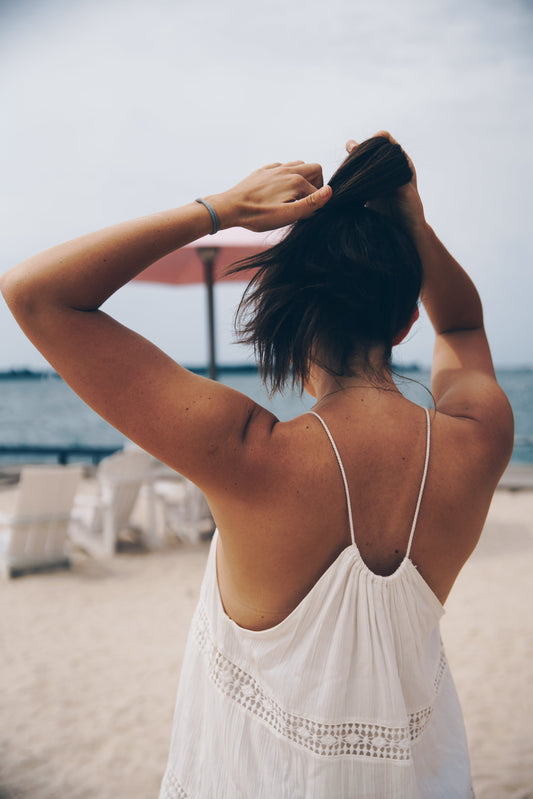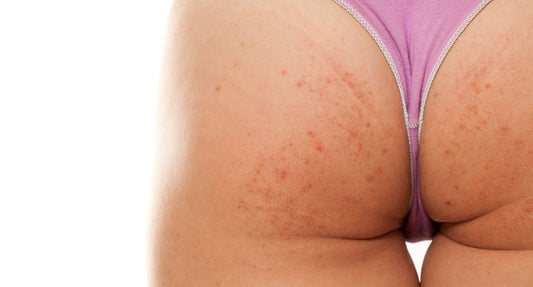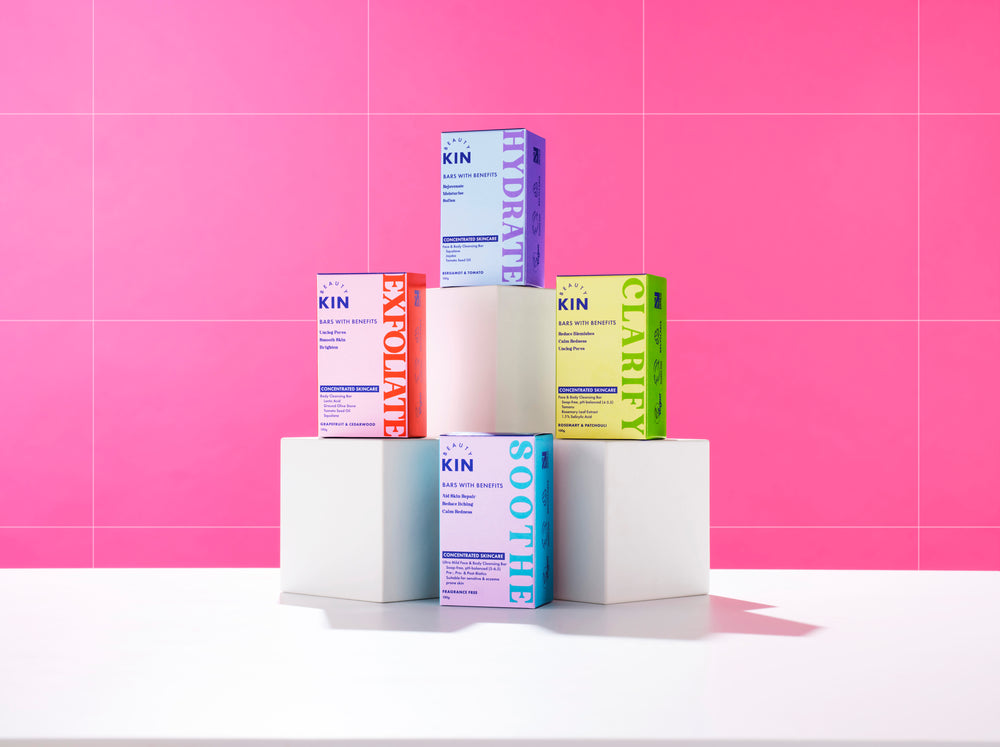
The alarm rings out across your bedroom, as the sun streams through the window pane. You run to the bathroom, brush your teeth, shave your legs and jump in the shower. But before you know it, a familiar burn starts to travel up your newly, smooth legs. By the time you’ve turned the shower off, your legs are red raw and small bumps are starting to form on your skin. It looks like it’s going to be a warm day. You were planning on wearing that beautiful new summer dress but now you want nothing more than to cover up and soothe the fire that is consuming your legs. We know it well.
The difference between shaving rash and razor bumps
The terms ‘shaving rash’ and ‘razor bumps’ are often used interchangeably but they are actually different conditions.
What is razor burn?
Razor burn or shaving rash refers specifically to the itchy, painful redness that emerges soon after shaving. It is considered to be a form of contact dermatitis, caused when blades disrupt the outer layer of skin forming tiny cracks, dryness and inflammation. It seems that people with more sensitive skin tend to be more prone to it butdepending on its severity, shaving rash typically disappears within a few hours or a few days.However, it can be accompanied by razor bumps, which can become infected if not treated properly.
What are razor bumps?
Razor bumps are small ingrown hairs caused when shaved hair curls back into the skin and grows underneath. They often appear as red and pimple-like and it is thought that people with coarse and curly hair are more susceptible. Their scientific name is pseudofolliculitis barbae and they are most likely to occur:
If not treated, razor bumps can cause permanent damage.
Both razor burn and razor bumps can be sources of frustration and pain not to mention highly detrimental to the overall health of your skin. While some skin and hair types may be more vulnerable to them, both shaving rash and razor bumps can affect any skin or hair type, if safe, careful shaving protocols aren’t carried out.

Why do I get razor burn?
The primary causes for razor burn are numerous but it can be easily prevented with thorough, effective skincare. While using an old razor, a blunt razor or a razor clogged with hair or soap can trigger shaving rash, it’s actually not always the razor’s fault. It’s important to remember that razors do require a certain amount of maintenance and need to be replaced. According to The English Shaving Company, you should replace your blades:
So, you definitely shouldn’t be using the same blades for months at a time.
Razor burn can also be caused by shaving too close to the skin, shaving against the direction of hair growth, shaving too fast or with too much pressure and of course, dry shaving or shaving without sufficient moisture.
Why do I get razor bumps?
Razor bumps are the result of hairs getting stuck in the follicles. Instead of growing straight out of the follicles, hair meets dead skin at the pores and curls back on itself, becoming ingrown. Therefore, razor bumps are often caused by poor exfoliation of the skin prior to shaving. Razor bumps and ingrown hairs can also be caused by many of the same things that cause shaving rash such as shaving too close to the skin, shaving against hair growth direction and shaving too fast.


How to treat razor burn and bumps
The pain, irritation and inconvenience of shaving rash and razor bumps aren’t things that you simply have to put up with. There are some highly effective solutions, techniques and advice that you can follow that will show you how to get rid of razor burn and razor bumps, hopefully for good.
So, how do you soothe the vicious burn that is currently creeping over your skin? The key to putting out the fire is to cool it down and get as much moisture into it as possible. Beauty Kin’s Hydrating body bar and Shaving body bar are both full of natural ingredients that will soothe the pain and redness of shaving rash while ensuring that your skin stays moist.
Another simple solution to razor burn is to place a cool, wet cloth on the area for around 20 minutes. You can also choose to calm it down with a natural astringent such as tea tree oil with water, which will reduce inflammation and redness.
Natural oils such as coconut oil, olive oil and avocado oil hydrate and soften the skin while aloe vera has been proven to reduce inflammation significantly.
There is also growing evidence that oatmeal has anti-inflammatory and anti-oxidant properties and can be especially effective when treating razor burn on the legs or pubic area.
There are also several over-the-counter products that will ease shaving rash. Ingredients to look out for include:
All of these ingredients will nourish and soothe symptoms of razor burn and encourage the skin to recover.
What about those itchy, unsightly razor bumps and ingrown hair? Pressing a warm towel to razor bumps for a few minutes will encourage ingrown hair to emerge from the skin. Warm compresses with green teabags have also proven to be effective when treating razor ingrown hair. Natural astringents like tea tree oil can be used to reduce the redness and itchiness of razor bumps as well as calm shaving rash.

How can I prevent them from returning?
It’s all very well treating them when they arise but why not get to grips with how to prevent ingrown hairs and how to get rid of razor burn forever? After all, the best, most permanent treatment is prevention.
The essential starting point is thorough exfoliation before shaving. Dead skin and clogged pores are a breeding ground for ingrown hair, so it’s important that your skin is fully prepared for a razor.
Ensure your razor is sharp and clean. Dull, blunt blades are likely to pull at the hairs and fail to shave properly, so you might be tempted to apply extra pressure to the razor in order to get a close shave. Naturally, this increases the chances of cutting the skin and shaving the hairs at an odd angle, resulting in razor bumps and ingrown hair.
You should also rinse the razor after every stroke in order to prevent it becoming clogged with hair and shaving lather.
Always shave when your skin is wet and warm. After showering or bathing is the optimum time, as the hair is at its softest. Use a gel or cream with gentle ingredients to add extra moisture to the skin during the shave.
Shave in the same direction that the hair grows to avoid excessive pulling and to ensure that the blades get the best angle on the hairs. This way, the hairs aren’t being pulled back on themselves and therefore, they shouldn’t curl back under the skin.
Take your time with your shave. Don’t go too fast or press too hard. Luxuriate in some you time, get rid of shaving rash and prevent ingrown hairs all at the same time!
Your post-shave care routine
The post-shave care routine is often the part that is neglected. Your skin has just had its top layer scraped away by a metal blade, so it’s as important to apply moisturiser to your skin after shaving as it is before the shave. Rinse the skin in cold water to open up the pores before applying an alcohol-free lotion to keep shaving rash and razor bumps at bay.

Beauty Kin to the rescue!
So, now that you know how to get rid of shaving rash and how to prevent ingrown hair, we’ve got some excellent products that are sure to help you achieve the silky, smooth shave that you want.
Our Shaving body bar contains squalane, a highly effective emollient that hydrates the skin throughout the shave while lavender acts as an anti-inflammatory to stave off razor burn. This body bar revitalises freshly shaved skin and leaves it looking and feeling its very best.
We’d also like to introduce you to our Hydrating body bar. Like the Shaving bar, Hydrating contains the very powerful component squalane and uses tomato seed oil to reduce redness and minimise pores. Ophthalmologically tested, it can be used on the face as well as all over the body, leaving fully nourished skin wherever it goes.
Razor burn and razor bumps can be a real pain and in some severe cases, ingrown hair can become infected. If you’re unable to get rid of shaving rash, razor bumps or ingrown hair yourself, be sure to see a doctor or dermatologist who will be able to help.
It’s time to stop putting up with the fiery wrath of razor burn and the seemingly inevitable appearance of razor bumps. Good moisturising before, during and after shaving, a clean sharp blade and taking things slowly and gently will make that familiar burn a thing of the past.





